
Custom View Mastery: How to Lock In and Retrieve Your Favorite Excel Spreadsheet Configurations

Custom View Mastery: How to Lock In and Retrieve Your Favorite Excel Spreadsheet Configurations
When working on an Excel worksheet, you may find yourself setting up different display settings at different times, such as zoom level or window position and size. The Custom Views feature allows you to set up and save different views to quickly switch among them.
For example, you may want to zoom in on the worksheet temporarily to see more details, or hide parts of the Excel interface to maximize your workspace (in addition to hiding the ribbon ). You can set up a different view for each worksheet and save each view. The following settings are included in custom views: the zoom level, the current cell selection, column widths and row heights, display settings on the Advanced tab of the Excel Options dialog box, the current size and position of the document window, the window pane arrangement (including frozen rows and columns ), and optionally print settings (including page setup) and hidden columns and rows .
Related: How to Freeze and Unfreeze Rows and Columns in Excel
Before setting up any custom views, it’s a good idea to save the current normal view as a custom view so you can easily revert back to it. To set the current view as the normal view, click the “View” tab.
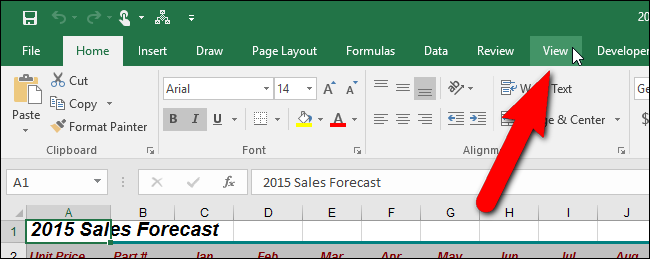
In the Workbook Views section, click “Custom Views” or hold Alt and press W, then C on your keyboard.
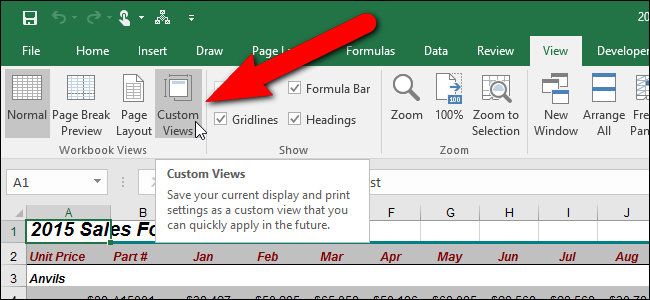
On the Custom Views dialog box, click “Add”
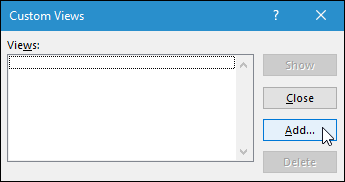
Type a unique name for the view in the “Name” box. Since this is our normal view, we named it “Normal 100%”. Either check or uncheck the “Print settings” and “Hidden rows, columns and filter settings” boxes depending on what you want to include in the view. Click “OK”.
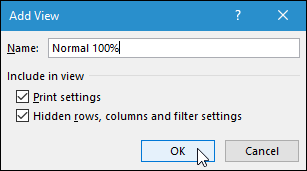
Now, we’ll create a custom view. As an example, we’re going to create a view with a 150% zoom and the Formula Bar and Headings hidden, so we can read our spreadsheet easily and have a bit more room on the worksheet. Set up the view the way you want it and then click “Custom Views” in the Workbook Views section on the View tab.
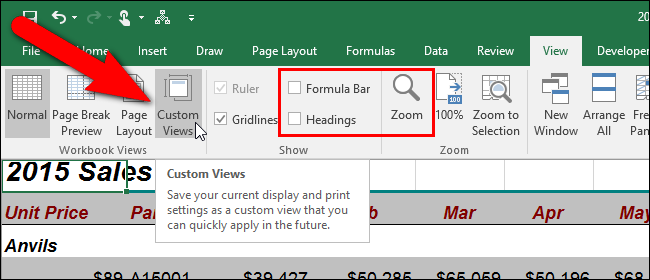
Click “Add” on the Custom Views dialog box.
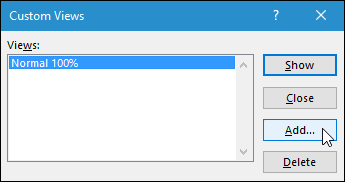
Enter a unique name for your custom view and check or uncheck the boxes under Include in view as desired.
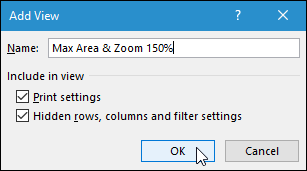
To switch views, click “Custom Views” in the Workbook Views section on the View tab, or hold Alt and press W, then C on your keyboard. Click on the view you want and click “Show”. You can also double-click the name of the view you want to show.
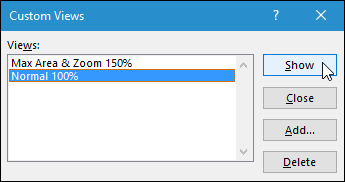
Custom views are only available in the workbook in which you create them, and they are saved as part of the workbook. They are also worksheet-specific, meaning that a custom view only applies to the worksheet that was active when you created the custom view. When you choose a custom view to show for a worksheet that is not currently active, Excel activates that worksheet and applies the view. So, you must create custom views for each worksheet in each workbook separately and be sure to save your workbook with your custom views.
Also read:
- [New] 2024 Approved Dominate Your Digital Space with These 10 Follower-Boosting Hacks
- [New] Enhance Your Movies Leading 3D Blu-Ray Equipment
- Best 7 Cost-Free Learning Tools for Kickstarting the Academic Year
- Comparing MAGIX Graphics Software Variants
- Diagnostic Policy Service Malfunction? Here's the Solution!
- Discover Apple's Top Tips for Crafting Exceptional Design on VisionOS - Featured on ZDNet
- Enhance Your Computer's Networking: Wi-Fi LAN Card Setup for OS X/Windows
- In 2024, Easily Alter Video Velocity YouTube's Playback Speed Mastery
- In-Depth Analysis Complete Revamp of Facetune App
- Reincarnation/Resurrection
- Solution Found for Persistent Restart Problems in Windows 10/11 Systems
- Stop Laptop Frustrations: Charge That Battery in No Time with These Fixes
- The Ultimate Solution for Completing Interrupted Windows Update Cycles
- Troubleshooting Crash Dump Failures for Wolfenstein II Players
- Troubleshooting Guide: When Radeon Settings Can't Be Accessed
- Troubleshooting Steps for Windows Device Path and File Accessibility Problems
- Warframe Update Woes? Here's How to Correctly Resolve the Notorious Update Failure
- Title: Custom View Mastery: How to Lock In and Retrieve Your Favorite Excel Spreadsheet Configurations
- Author: Anthony
- Created at : 2025-01-18 17:33:35
- Updated at : 2025-01-25 17:46:24
- Link: https://win-howtos.techidaily.com/custom-view-mastery-how-to-lock-in-and-retrieve-your-favorite-excel-spreadsheet-configurations/
- License: This work is licensed under CC BY-NC-SA 4.0.